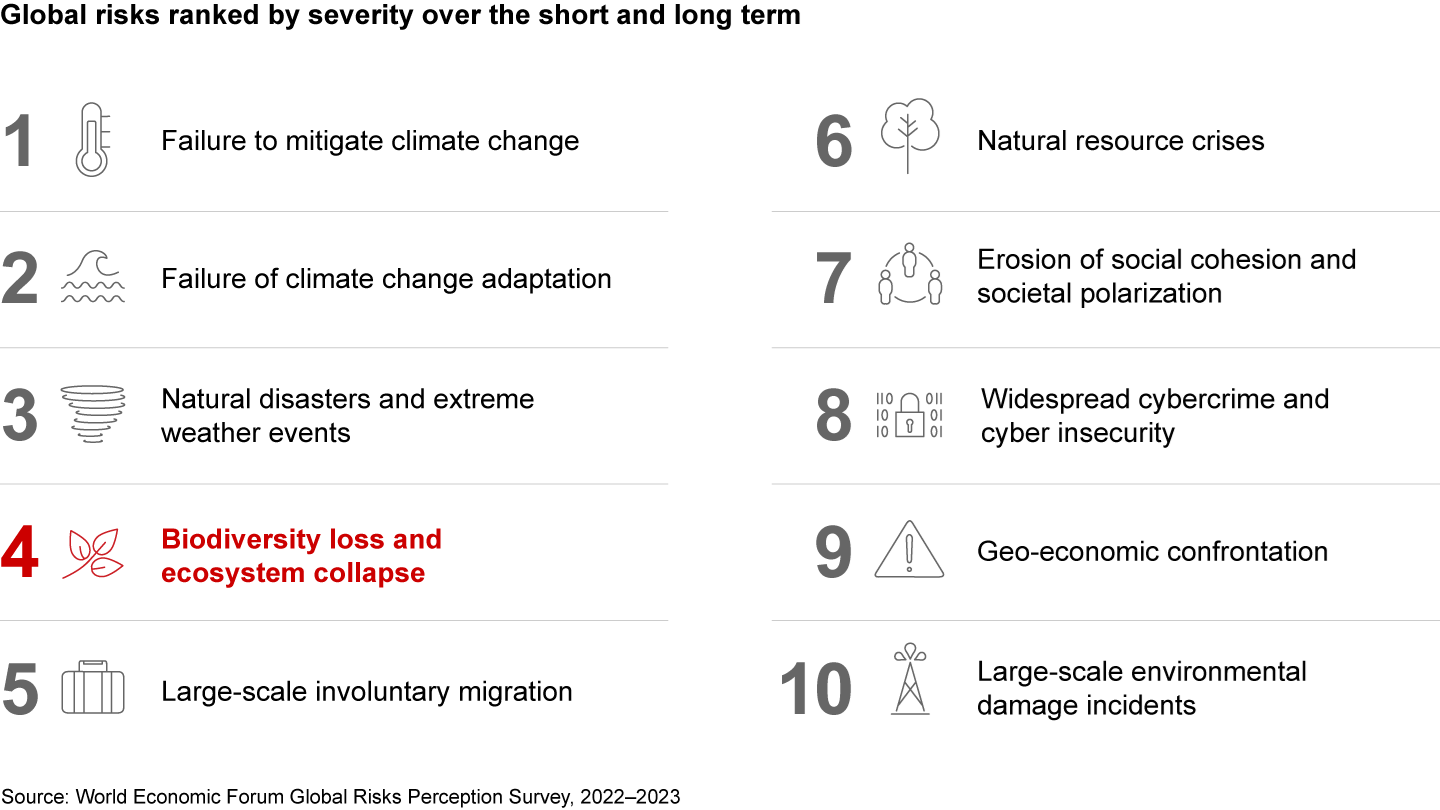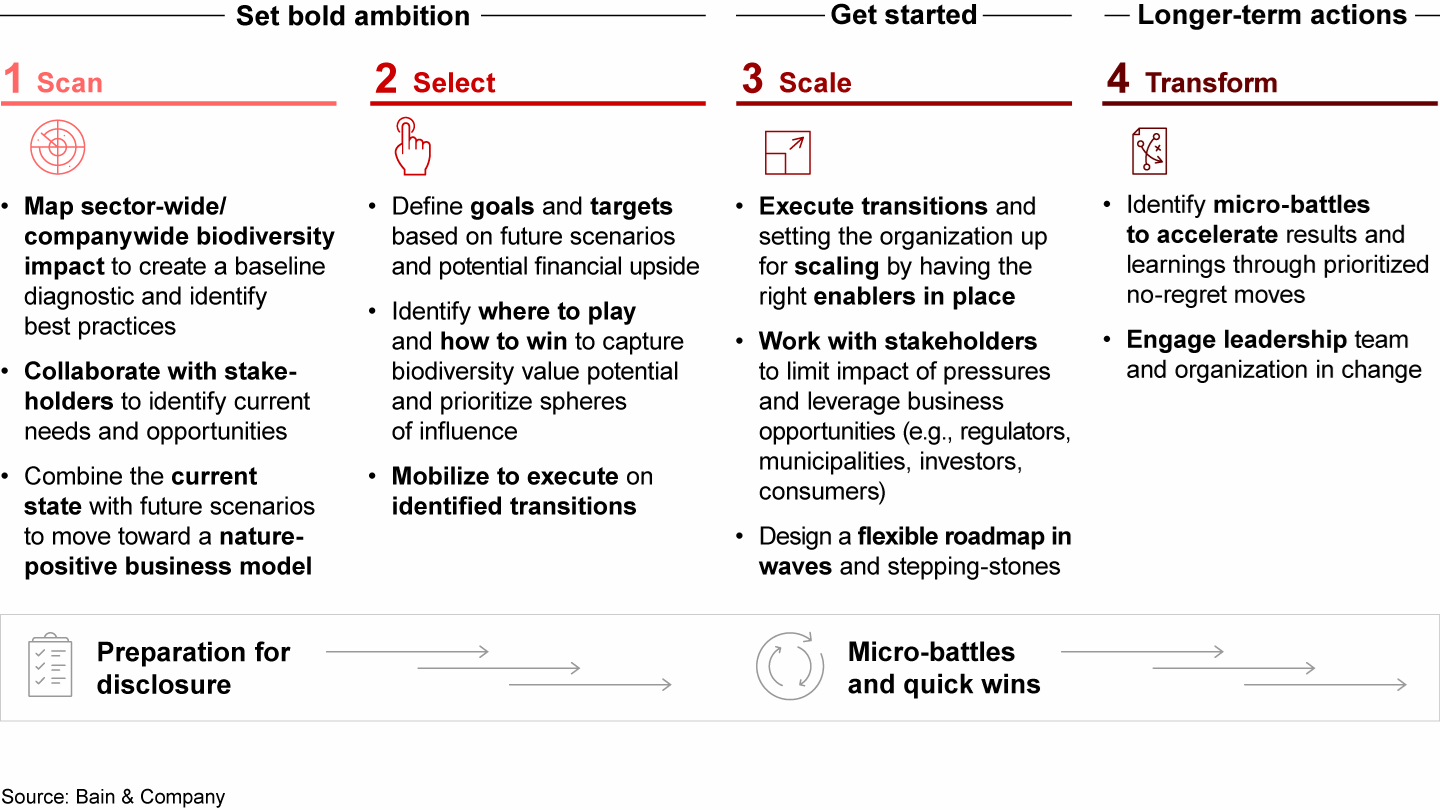The Paper and Packaging Industry Faces a Biodiversity Crisis
The Paper and Packaging Industry Faces a Biodiversity Crisis Bain & Company


Biodiversity Loss: A Threat to Nature and the Economy
This article is part of Bain’s 2023 Paper & Packaging Report
The Impact of Biodiversity Loss on the Global Economy
The World Economic Forum (WEF) estimates that nature and biodiversity loss could put $44 trillion, more than half of global GDP, at risk. In a recent WEF survey, global risk experts ranked biodiversity loss and associated environmental risks as the most critical threats to the global economy within the next decade.
The Interconnectedness of Biodiversity Loss and Climate Change
Populations of mammals, birds, amphibians, reptiles, and fish have declined by 69% since 1970, and around 1 million species globally are at risk of extinction. Biodiversity loss and climate change are interconnected, as climate change accelerates biodiversity loss. The destruction of ecosystems undermines nature’s ability to regulate greenhouse gas emissions and protect against extreme weather, thus speeding up climate change and increasing vulnerability to it.
Opportunities for Companies to Act
Leading companies are reducing their exposure to biodiversity-related risks and brand risk by implementing sustainable forestry practices and increasing the use of recycled and reused materials. They are also developing innovative packaging solutions with lower carbon and biodiversity footprints to target new markets. By addressing biodiversity impact in their supply chains, companies can appeal to customers who are increasingly concerned about reducing their environmental impact.
Biodiversity Loss as a Global Risk

The Role of Paper and Packaging in Biodiversity Loss
Paper and packaging companies contribute to biodiversity loss through unsustainable forestry management and the use of forestry resources as raw materials. Large-scale clear cutting, particularly in Sweden, is an unsustainable forestry practice. Water use in the industry also impacts biodiversity, as it leads to air, water, and soil pollution. Even companies not directly involved in forestry contribute to biodiversity loss through their supply chains and consumer consumption.
Current Actions and Future Plans of Paper and Packaging Companies
Only a minority of paper and packaging companies are currently taking action on biodiversity loss. However, about 45% of companies surveyed plan to assess their biodiversity impact within the next two years, and 35% plan to take action. The challenge lies in prioritizing biodiversity alongside climate change, as regulations, investor pressures, and incentives for biodiversity are less developed compared to those for emissions.
Forest Certification Schemes and the Need for More
Most paper and packaging companies follow forest certification schemes, but these are not enough. Companies need to consider their unique conditions and tailor their approach to address biodiversity loss. Additional regulations and legislation are needed to accelerate responses from companies and protect biodiversity.
Emerging Regulations and the Importance of Legislation
New biodiversity legislation, regulations, and reporting standards are under development to pressure companies to prevent biodiversity loss. Global biodiversity targets have been set, including the conservation of 30% of the planet’s lands and oceans by 2030. The EU and the US have also committed to protecting and conserving a significant portion of their lands and seas. Goals and commitments worldwide need to be translated into regulations and legislation to drive action.
Sustainable Forestry Strategies in Europe and South America
Leading paper and packaging companies are using sustainable forestry practices to improve biodiversity. For example, SCA in Europe has set aside over 160,000 hectares of forest land for promoting biodiversity. Brazilian company Suzano is committed to connecting fragmented forests in Brazil to extend habitat and increase genetic variability.
Innovating Products and Supply Chains
Companies are developing innovative packaging solutions using sustainable raw materials and optimizing supply chains to protect biodiversity. New regulations on deforestation-free products, such as those in the EU, are changing market dynamics and creating financial incentives for companies to address biodiversity loss. Companies are also learning from biodiversity leaders in other industries to manage biodiversity in their supply chains.
Reducing Biodiversity-Related Risks
By implementing sustainable forestry practices and sourcing from resilient fibers, companies are reducing their biodiversity-related risks, including physical and reputational risks. Ignoring physical risks can lead to input price increases, raw material shortages, and reduced resilience to outbreaks. Companies need to prioritize biodiversity to maintain forest resilience and prevent biodiversity loss.
A Strategic Approach to Safeguarding Biodiversity

A structured approach can help businesses define their biodiversity strategy:
- Scan: Map sector-wide and companywide biodiversity impact, collaborate with stakeholders, and assess biodiversity risks and opportunities.
- Select: Define goals and targets, identify biodiversity value potential, and set targets based on future scenarios.
- Scale: Execute transitions, work with stakeholders, and design a flexible roadmap.
- Transform: Take longer-term action, identify pilot projects, develop new capabilities, and involve the entire value chain.
Making the business case for biodiversity will help scale efforts. Companies can set bold targets, such as being biodiversity positive or nature positive by 2030, and adjust their roadmap based on continuous learning.
SDGs, Targets, and Indicators Relevant to the Article
1. Which SDGs are addressed or connected to the issues highlighted in the article?
- SDG 13: Climate Action
- SDG 14: Life Below Water
- SDG 15: Life on Land
2. What specific targets under those SDGs can be identified based on the article’s content?
- SDG 13.2: Integrate climate change measures into national policies, strategies, and planning.
- SDG 14.2: By 2020, sustainably manage and protect marine and coastal ecosystems to avoid significant adverse impacts.
- SDG 15.5: Take urgent and significant action to reduce the degradation of natural habitats.
3. Are there any indicators mentioned or implied in the article that can be used to measure progress towards the identified targets?
- Percentage of companies assessing their value chain impact on biodiversity (Indicator for SDG 13.2)
- Percentage of companies planning to begin assessing their biodiversity impact within two years (Indicator for SDG 13.2)
- Percentage of companies acting now to address biodiversity loss (Indicator for SDG 14.2)
Table: SDGs, Targets, and Indicators
| SDGs | Targets | Indicators |
|---|---|---|
| SDG 13: Climate Action | 13.2: Integrate climate change measures into national policies, strategies, and planning. | Percentage of companies assessing their value chain impact on biodiversity |
| SDG 14: Life Below Water | 14.2: By 2020, sustainably manage and protect marine and coastal ecosystems to avoid significant adverse impacts. | Percentage of companies acting now to address biodiversity loss |
| SDG 15: Life on Land | 15.5: Take urgent and significant action to reduce the degradation of natural habitats. | Percentage of companies planning to begin assessing their biodiversity impact within two years |
Behold! This splendid article springs forth from the wellspring of knowledge, shaped by a wondrous proprietary AI technology that delved into a vast ocean of data, illuminating the path towards the Sustainable Development Goals. Remember that all rights are reserved by SDG Investors LLC, empowering us to champion progress together.
Source: bain.com

Join us, as fellow seekers of change, on a transformative journey at https://sdgtalks.ai/welcome, where you can become a member and actively contribute to shaping a brighter future.







